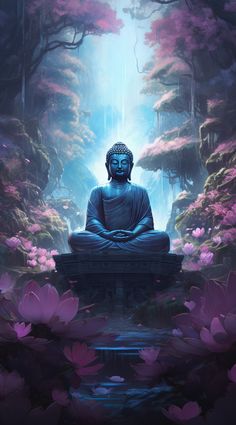The triple poisons come from nescience!
The Buddha was awakened to the truth of the problem of the triple poisons of desire, divisiveness, and delusion, and of the solution of suffering, strife, and samsara. He found that they come from karma. He taught us to know the Dharma and to practice the triple learnings of morality, concentration, and prognosis to solve them.
If we know the Dharma of Dependent Co-origination of all phenomena, we see that our suffering comes from desire, like the thirst that causes us to drink sea water when shipwrecked, even if we know that it makes us thirstier. We can apply the four holy truths of suffering, its cause, its cessation, and the eight holy ways to solve it.
Our divisiveness, anger, fighting, and war come from our ignorance and inaction in solving them. If we know the Dharma of Dependent Co-origination of all phenomena, we can understand that there is no separate, sovereign self from others, and that we must co-exist in holy (wholly wholesome) harmony, friendship, and peace.
Our samsara (constant change) through the six ways (states) of humans, animals, fighting devils, celestials, hungry ghosts, and hell beings comes from our nescience (no witness) of nirvana (no wind, of karma) due to constant karma kinetics (action, habits, heredity) for food, mates, etc. Nirvana makes us awakened (buddha).
May 18, 2024 C.E.
Note:
- Nescience (avijjā/avidyā) means no witness of nirvana (no wind, of karma) and the world in it (cf. Latin video) due to our being karma-machines, like a mouse continuously running on a treadwheel, not stopping to sit still, settle in nirvana, and see the Dharma, serving and saving all.
- Dharma means 1. form (from d-harm: phenomenon) and 2. norm (from d-h-arm: norm: law operating through phenomena: ethic), and 3. the teaching of the law of all phenomena, that is, Dependent Co-origination (originally awakened on the origination of perception/consciousness depending on the sense organs and objects, but later applied to all phenomena, cf. note 5). This law is similar to the law of causality, now used by sciences, but deeper and wider, applied beyond objects – more on subjects and symbols – ideas, etc.).
- “The Dharma (Norm/Law/Truth/Ethic) of all dharmas (forms/phenomena/ truths/ethics)” is Dependent Co-origination, i.e., all phenomena are interdependently co-originated on limitless causes and conditions (similar to the Law of Causality, but deeper and wider – beyond conventions, conceptions, objects, etc.). This means that we are interrelated with other beings (other species, elements, stars, etc.), and relatives to each other, and that we must therefore live together harmoniously and strive to make a wholly wholesome world to become harmonious, health, and happy.
- The twelve-limbed Dependent Co-origination (bhava-cakka/bhava-cakra, becoming wheel) is the most well-known representative application of the Dharma of Dependent Co-origination, though it is misinterpreted due to its linear presentation by oral tradition and the Hindu idea of transmigration (an embryogenetical interpretation called two causalities in three generations). Actually, it is a compound formed from the Dependent Co-origination of consciousness on sense organs and objects, of suffering on craving, and of samsara (total flow: moment-to-moment change, not like transmigration in Hinduism) on appropriation. It illustrates how our life goes with the five aggregates (originally identifying and analyzing so-called “self,” later “world”), resulting in suffering due to the triple poisons.
Please refer to part 3 of “Why Buddhism Now?” for a detailed explanation with the structural system of the “Becoming Wheel” (bhava cakka/cakra):
https://buddhism869196463.wordpress.com/%e3%83%9b%e3%83%bc%e3%83%a0%ef%bc%9ahome/
- The Six Ways (States) of human being, celestial being, animal being, fighting devil, hungry ghost, and hell beings are alegorical states of our mind-world states from moment to moment, not like the Hindu idea of being born to be such after death.
- The four holy truths are that of suffering (duk-kha, wrong-going, going against wishes), cause of it (identified as craving: taṅhā/tṛṣṇā, lit. thirst, as drinking seawater), cessation of it (identified as nirvana: no-wind, cf. nivāte padīpa: lamplight in no-wind), and way for it (identified as the eight holy ways).
- The eight holy (ariya/ārya) ways (ariya-aṭṭhaṅgika-magga/ ārya-aṣṭāṅga-mārga) are right view (sammā‑diṭṭhi/ samyag-dṛṣṭi), right thinking (sammā-saṅkappa/ samyak-saṃkalpa), right speech (sammā-vācā/ samyag-vāc), right action (sammā-kammanta/ samyak-karmānta), right livelihood (sammā-ājīva/ samyag-ājīva), right striving (sammā-vāyāma/ samyag-vyāyāma), right mindfulness (sammā-sati/ samyak-smṛti), right concentration (sammā-samādhi/ samyak-samādhi).
三毒は業に由来する!
ブッダは私達の貪瞋痴三毒の問題と苦争輪廻の解決の真理に目覚めた。彼はそれが業に由来することを見出した。彼は私達にそれを解決する為に法を知り三学を実践することを教えた。
もし私達が一切現象の縁起(因縁生起)の法(法則:真理)を知れば、私達の苦は、難破して、海の水を飲めばもっと渇くと知りながら、私達に海の水を飲ませる渇きのように、渇愛にゆらいすることが判る。私達は苦、その原因、その停止、それを解決する八聖道の四聖諦を適用できる。
私達の分裂、怒り、争い、戦争は私達がそれを解決することの無知、無行動に由来する。もし私達が一切現象の縁起を知れば、他から離れ、主宰となる我は存在せず、私達は聖(全体健全)な調和、友情と平和に共存しなければならないことが理解できる。
私達の人間、修羅、動物、天人、餓鬼、地獄の六道(状態)の輪廻(常時変化)は食料や同伴に対する常時の業動態(行動、習慣、遺伝)による涅槃(無風、業の)の無明(無直証)に由来する。涅槃は私達を覚醒(ブッダ)させる。
2024共通年5月18日
註:
1.無明(無確証: avijjā/avidyā))は、私達が、鼠が踏み車を踏み続けるように、業機械として止まらず、静坐せず、涅槃に安住せず、法を見ず、一切に奉仕、救済しない為に涅槃(無風、業の)とその中に在る世界を直証(参照:ラテン語video)しないということである。
2.法(dharma)は 形態(form: d-harmより: 現象:真理)、2.規則(norm: d-h-armより:現象中の規則:倫理)、3.諸法の法、縁起(元来は感覚器官と感覚対象に依る知覚・意識の発生に覚醒したが後に一切現象に適用されたもの。註5参照)。この法則は、現今諸科学に用いられる、因果律と同様であるが、もっと深く広い-客体を越えて主体と観念などの象徴に適用される。
3.諸法(形態・現象)の法(規則・法則・真理・倫理)は縁起(因縁生起)、即ち、一切現象は無量の直接原因と間接条件により相依生起するということである(因果則に似ているがさらに深く広い-世俗、観念、対象などを超える)。これは私達が他者(多種、要素、星宿など)と相依関係にあることを意味し、相互に相対的であり、私達が調和、健康、幸福になる為には共に調和して生き、全体健全な世界を作る努力をしなければならないことを意味する。
4.十二支縁起(bhava-cakka/bhava-cakra、生成輪、輪廻輪)は縁起の法の適用例の最もよく知られた代表ですが、口碑による線形の表出(三世両重の因果と呼ばれる胎生学的解釈)の為とヒンズー教の輪廻説により誤解されている。実際には感覚器官と感覚対象にって共縁起する意識、割愛による苦、専有(同定:執着)によるサンサーラ(全流:全体刻々変化の意で、ヒンズー教の輪廻ではない)の複合形です。(元来は所謂「自己」後に世界を同定し分析する為の)五蘊と共に、三毒の故に苦に成る私達の生がどのように展開するかを例示したものである。
5.人、天、畜生、修羅、餓鬼、地獄の六道(境涯:状態)は刻々の私達の心‐境(境涯:心‐世界)の比喩的状態のことで死後に生まれるものヒンドゥー教の考えとは違う。
6.四聖諦(catur-ārya-satya/cattāri ariya-saccāni)は苦 (duk-kha, 上手く行かない:不満), その原因 (欲:taṅhā/tṛṣṇā, 字義:海水でも飲む渇愛), その滅 (涅槃: 無風、業の, cf. nivāte padīpa: 無風の灯明), とその道程 (八聖道). 聖(ariya/ārya) は全体健全(全体が健全:調和、健康、幸福)であること。
7.八聖 道 (ariya-aṭṭhaṅgika-magga/ ārya-aṣṭāṅga-mārga) は正見 (sammā‑diṭṭhi/ samyag-dṛṣṭi), 正思 (sammā-saṅkappa/ samyak-saṃkalpa), 正語 (sammā-vācā/ samyag-vāc), 正行 (sammā-kammanta/ samyak-karmānta), 正業 (sammā-ājīva/ samyag-ājīva), 正精進 (sammā-vāyāma/ samyag-vyāyāma), 正念 (sammā-sati/ samyak-smṛti), 正定 (sammā-samādhi/ samyak-samādhi)。
.
.
.
.
.
.
.
.
.
.
.


